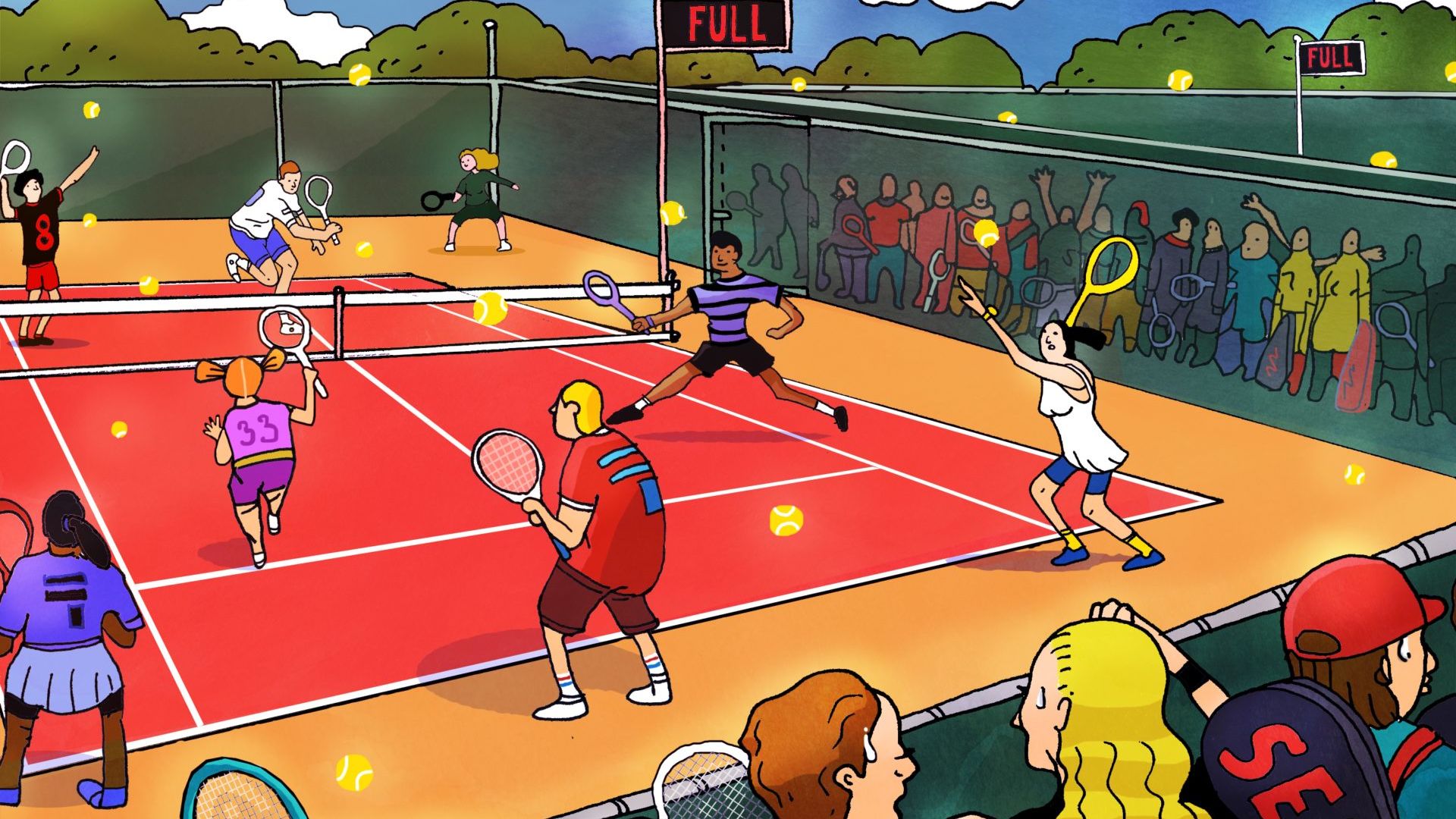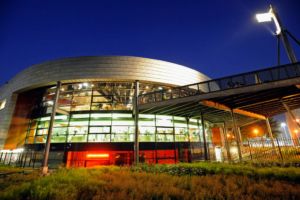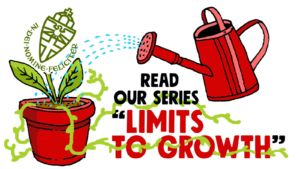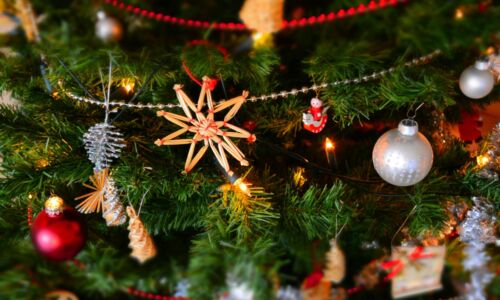Limits to growth (4): ‘clever organisation’ instead of an extra sports hall
-
 Illustration: Ivana Smudja
Illustration: Ivana Smudja
Every year Radboud University grows a little bigger. How do fuller lecture halls impact teaching, student life and the city of Nijmegen? In the Limits to growth series, Vox explores the university’s growing pains. Today, Part 4: The sports centre that’s bursting at the seams.
‘I prefer to do sports in the afternoon after my classes,’ said powerlifter Martijn Hendriks. ‘But that’s peak time when the whole fitness facility is full. I tried going to the sports facility in the morning, but then I had to reschedule my week, And during the last lockdown, it was almost impossible to use the sports facility: you had to reserve a time slot days in advance. So I also joined another sports school and now I can practice whenever it suits me – but it costs me an extra 30 euros a month.’
Limits to growth
In the coming weeks, Vox will highlight the steady growth of Radboud University. This is the fourth article in the series.
1. The growing pains of the university
2. Active student life under pressure
3. Fighting for office space
4. The sports centre is bursting at the seams
5. The explosion of psychology in 2016
6. Is the campus still easily accessible?
7. Lecture halls full of unhappy students
8. Student recruitment without growth ambitions
Hendriks isn’t the only one who’s noticed the lack of space at Radboud Sports Centre (RSC). Too few playing fields or rooms available, long waiting lists or even sports clubs with complete membership stops, teams looking for accommodation elsewhere in the city and a fitness room that’s full to the seams. The sports centre is full – full to bursting.
There’s a logical explanation for this problem: Radboud University has grown considerably over the past few years. This growth is reflected in official figures, which show that the number of students at the university has risen by 35 percent in the last ten years.
Membership stop
This growth also means more students who want to play sports. Peter Gijsberts, team leader of the student sports association on behalf of the sports centre, confirms this: ‘Over the past few years, club membership has grown by an average of 10 to 15 percent.’ According to an internal memo dated September 2020 written by Rob Cuppen, the former director of the sports centre, about 20,000 people were a member of the sports centre each month. This made RSC the busiest university sports centre in the country. But it should be noted that, according to the sports centre, the current number of students ‘is much lower’ and ‘fluctuates a lot because of the COVID-19 crisis.’
However, there are no hard figures, partly because of the fluctuating numbers during the crisis. The popularity of the sports centre gives rise to a number of problems. A questionnaire held by Vox at various student associations showed that 60 percent of the sports clubs now have a membership stop – the main reason being a lack of capacity.
If you look at the current lack of space as well as the continual growth, you may quickly jump to the conclusion that more sports facilities should be built as soon as possible. But that’s not going to happen.
‘It’s all about previous ideas; there won’t be any expansion’
In the past few years there were numerous rumours about new construction. For example, an extra sports hall where the tennis courts are now situated, an extra storey on top of the existing sports centre or new sports fields – perhaps even a new sports hall – in nearby Park Brakkenstein.
‘We’ve also heard those stories,’ said Gijsberts with a laugh. ‘But I have to say that that last plan was new even for me. But let’s be clear: it’s all about previous ideas. There won’t be any expansion.’
Extra sports hall
It’s true that Cuppen, a former director of the sports school, advocated the construction of a new sports hall. ‘Where the tennis courts are currently located. The idea was to use the hall as a multifunctional facility: as an exam location during the day and a sports facility in the evening. But the Executive Board wasn’t convinced. It was finally decided to convert the former administrative building on Comeniuslaan into an exam location, and this plan was scrapped.’
As the Vox questionnaire showed, Cuppen’s plea for extra space was shared by many clubs, including Trajanum (basketball), FC Kunde (football), Apeliotes (hockey), Slow (tennis) and Ha-Stu (handball), all of which say that they simply need more space in order to let their members play. FC Kunde and Apeliotes gave a more detailed explanation in a previous article.
The internal document from September 2020 also showed how vital the extra space is. As stated there, ‘the further growth of the clubs that play indoor sports is only possible if a third sports hall is built.’ If the number of sports cardholders remains more or less the same in the future, then the current space for the clubs still won’t be enough.

Gijsberts: ‘I understand that clubs want more construction, but their demand is too simple. This kind of plan has to conform to the financial and spatial requirements and there has to be a vision for the future. And even if we manage to provide all this in the short term, when do you think that that new hall can be used? It’ll take years.’
‘Just to be clear, we did indeed talk about new accommodation in the past. But for various reasons it was never realised. But it’s also not true that we were never given extra space: just a few years ago we were able to expand the fitness room considerably. But if you argue time and again for an extra hall, then you have to take a different approach.’
‘The most important thing is to realise that there’s simply not one all-encompassing solution’
According to Joris Hermans, head of sports at RSC, the alternative was ‘to look for hybrid solutions. I don’t consider the lack of capacity to be such a serious problem that we have to build more, but rather as a problem that we can tackle by clever organisation. It’s all about how you use the existing spaces. The most important thing is to realise is that there’s not just one all-encompassing solution. The problem – and the solution – differs for each club.’
The Spinoza Building
A good example of this kind of solution is using spaces for something other than what they were originally intended for. ‘Some cultural clubs use the empty rooms in the Spinoza Building as rehearsal rooms,’ said Laura Lensink of the NSSR, the umbrella organisation of various student sports clubs. ‘The pole dancing club Lasya will probably practice there soon. And behind the scenes we’re actively searching for similar solutions.’
Director Hermans: ‘Another example is working with non-university clubs. For example, FC Kunde has recently been playing football on the fields of the Union football club (see insert, ed.). There are a number of other tennis, hockey or football facilities near the university; together with the municipality of Nijmegen and other clubs, we’re looking into these possibilities.’
Gijsberts: ‘Obelix (rugby, ed.) had a combined team together with the non-university club The Wasps in the past too. The players from both teams joined together so that an extra league team could be registered.’
FC Kunde practices at Union
The football club FC Kunde is one of the sports clubs faced with a shortage of playing fields and a waiting list for new members. To tackle both problems, Kunde created a committee to find a solution. After numerous meetings as well as extensive discussions with the sports centre and the municipality of Nijmegen, the solution the committee came up with was to use Sportpark De Kluis, home of Union football club.
‘The most important factor for us was that the football club was no more than a 15-minute bike ride from the sports centre,’ explained Aldwin Ransijn, who was on the above-mentioned committee on behalf of FC Kunde. ‘After we’d talked with a number of clubs in the area, Union seemed our best option. We have a rotation system in which teams practice at Union at certain intervals. As a result, we were able to register two extra teams after the winter break. This way, if we want to grow in the future and register more teams, there’s enough capacity there.’
‘This kind of collaboration isn’t really that strange,’ Hermans reasoned. ‘We also use the Erica Terpstra Sportfondsenbad and Triavium skating rink because, of course, we’re not going to build our own swimming pool or skating rink. Water sports clubs like Phocas (rowing) or the Loefbijter (sailing) also can’t practice at the sports centre.’
There are other clubs who practice at external locations. For example, Dance Fever (dance) and Heyendaal (volleyball) used the Jan Massink Hall before it was needed by the GGD (Public Health Services) as a vaccination location (it is currently a refugee shelter, ed.), KUNST (gymnastics) uses the facilities at SportQube and basketball club Trajanum practices in a gym in Nijmegen-Noord. ‘It’s great to be able to have extra practices, but it’d be even better if they could take place in the sports centre,’ said Toon van Tendeloo, chair of Trajanum. ‘Now you’ve got less contact with other teams.’
Meeting one another
Former sports centre director Cuppen always emphasised the fact that the sports centre is more than a sports facility. By this he meant that it was also important that students from various programmes or faculties could meet one another there.
Cuppen’s successor Hermans shares this conviction, but he qualifies it somewhat. ‘Our primary goal is to stimulate the campus to exercise. To have as many students and staff as possible playing sports. Of course, we like to see sports and meeting one another go hand in hand, but this doesn’t have to take place only at the sports centre – it can also happen elsewhere. In keeping with this line of thinking, it’s actually good to work together with non-university clubs.’
The lack of space is being discussed not only at club level, but also by the Executive Board. Rector magnificus Han van Krieken thinks that, in addition to using external locations, there are other options to consider: ‘We have to ask ourselves who the sports centre is actually for,’ he said while thinking out loud. ‘There was a time when athletes who weren’t connected to the university paid a higher fee. There are currently more sports schools in Nijmegen than there ever used to be.’
‘As RSC, we offer our services primarily to the university community’
The rector is referring to excluding athletes who aren’t connected to the university. But Hermans and Gijsberts think that this approach is too negative, although they both agree that this kind of solution is being considered. Hermans: ‘As RSC, we are primarily for the university community. That’s why I think that collaborating with non-university clubs is also a good solution for the transition of athletes. Students can continue to plays sports there after they graduate.’
No ready-made solution
Cuppen sees no benefit whatsoever in such a solution. ‘The problem of capacity lies mainly with the indoor and outdoor sports clubs. Excluding non-university athletes doesn’t solve that problem, but it does mean that you lose income.’
In addition, athletes who aren’t affiliated with the campus pay a higher monthly or annual fee for their sports card. Neither Hermans or Gijsberts was willing to say whether or not that fee might increase.
It’s clear that there’s no ready-made solution for the present lack of space in the sports centre. ‘But that doesn’t mean that we’ve stopped looking for solutions,’ Hermans concluded.




